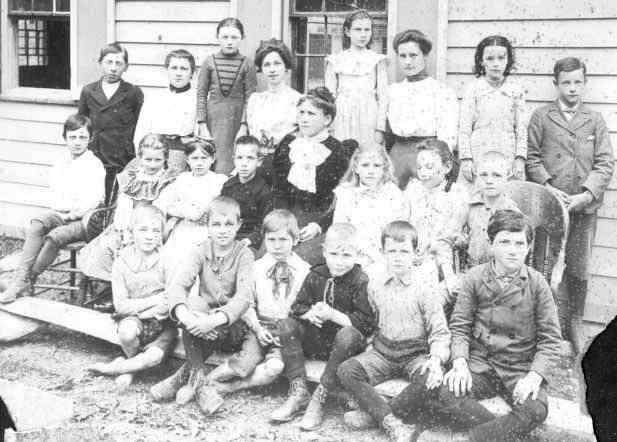
Figure 1.--Here we see a small rural school. The photograph is undated, but was probanly taken in the late 1890s. The boys wear knee pants. Some are barefoot, others wear long stockings. |

|
Most American boys did not wear uniforms to school. This was especially true in the 19th century. Only a few privte schools, mostly military schools had uniforms. We have relartively little information about the early 19th century, but beginning in the mid-19th century thanks to photography we begin to have nore information available. This continued into the 20th century. Few schools had uniforms in the early and mid-20th century. There were some exceptions. The parochial schools has simple uniforms. Many private schools had uniforms. The vast majority of American children, however, went to schools with out any uniforms. The clothes worn to school were thus a reflection of popular styles of the day. There were dress codes in many schools. As a result, some popular styles were not worn to school. Few high schools, for example, let children wear jeans to high school in the 1960s. Uniform were generally consdered elitist and discouraging individuality. These ideas began to change in the 1980s as some elementary schools began experimenting with voluntary uniforms. It must be remembered in building this chronology that there was not one single American experience and that regional trends were often quite significant.
Most American boys did not wear uniforms to school. Of course the public school system was just begining to develop in the early 19th century. We have relartively little information about the early 19th century, but beginning in the mid-19th century thanks to photography we begin to have nore information available. We see almost no children wearing uniforms in the early 19th centuty. The one exception was military schools. We are not sure when the first military school was founded. but we know they existed before the Civul War. We note some private schools organized along English lines. Again we are not sure when they were founded, but they were well established by the late-19th century. With these exceptions, children wore their own clothes throughout the century. Thus school clothes were a good reflection of the fashions of the day.
We also see few children wearing uniforms at the turn of the 20th century. This continued through much of the mid-20th century. There were some exceptions. The parochial schools has simple uniforms. Many private schools had uniforms. The vast majority of American children, however, went to schools with out any uniforms. The clothes worn to school were thus a reflection of popular styles of the day. There were dress codes in many schools. As a result, some popular styles were not worn to school. Few high schools, for example, let children wear jeans to high school in the 1960s. Uniform were generally consdered elitist and discouraging individuality. These ideas began to change in the 1980s as some elementary schools began experimenting with voluntary uniforms. These uniforms were especially prominent at inner-city schools. It must be remembered in building this chronology that there was not one single American experience and that regional trends were often quite significant.
We do not yet have much information on the 21st century. We do have a page on the 2000s. Uniforms were becoming an increasingly accepted feature of American schools. This is a major development in a country where public school children have not traditionally worn school uniforms. A California resident reports, "The local Catholic school has the kids wearing white polo's and navy shorts or long pants. The girls can wear shorts, pants or skirts. The shorts seem to be Bermuda legenth and not the long baggy look which are not permitted." A southern reader reports, "Lots of boys wear shorts to school which is part of their uniform here in the South. Uniforms are becoming a requirement in many of the schools." Uniforms are influencing what is being worn at non-uniform schools. Uniforms are worn in primary and middle schools, but not secondary schools.
Related Chronolgy Pages in the Boys' Historical Web Site
[Main Chronology Page]
[The 1900s]
[The 1910s]
[The 1920s]
[The 1930s]
[The 1940s]
[The 1950s]
[The 1960s]
[The 1970s]
[The 1980s]
[The 1990s]
[The 2000s]
Navigate the Relate Boys Historical Clothing Style Pages
[Main U.S. country page]
[Long pants suits]
[Short pants suits]
[Lederhosen]
[Knee Socks]
[Eton suits]
[Jacket and trousers]
[Blazer
[School sandals]
Navigate the HBC Country School Pages
[Main U.S. School Page]
[Main National School Page]
[Australia]
[England]
[France]
[Germany]
[Ireland]
[Italy]
[Japan]
[New Zealand]
[Poland]
[Singapore]
[Scotland]
[Singapore]
Navigate the HBC School Section
[About Us]
[Activities]
[Chronology]
[Clothing styles]
[Countries]
[Debate]
[Economics]
[Garment]
[Gender]
[Hair]
[History]
[Home trends]
[Literary characters]
[School types]
[Significance]
[Transport and travel
[Uniform regulations]
[Year level]
[Other topics]
[Images]
[Links]
[Registration]
[Tools]
[Return to the Historic Boys' School Home]
